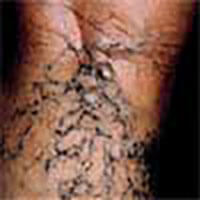Spider veins (Telangectasia )
What are spider veins?
Covering small or large areas of the skin, spider veins appear just below the skin & can take on the appearance of a web like structure. Spider veins can also look like a network of roots or branches of a tree.

What are the differences between spider veins and varicose veins?
Also known as telangiectasia, spider veins are similar to varicose veins but are much thinner in diameter (between 0.5 -1mm). Spider veins are usually closer to the skin than varicose veins but are not normally palpable (can't be touched).
Spider veins are usually blue or red compared to the dark blue or purple of larger varicose veins which have greater blood volume. They can develop anywhere on the body (including the eye) but usually develop over the face (cheeks, chin and nose) and on the legs; particularly around the ankles, below the knee and on the upper thigh area.
What causes spider veins?
Spider veins are caused by pooled blood in a vein. The role of a vein is to carry oxygen depleted blood from the body back to the heart. The blood moves in one direction along the vein. Valves in a vein prevent blood from flowing backwards.
However, if the valve becomes weak blood can flow back into the vein and build up. This process is known as 'venous insufficiency'.
The process of pumping blood back to the heart from the legs can strain the vein valves. Spider veins are often found on the legs due to the higher pressures needed to pump blood from near ground level to the heart. Spider veins can also be be found on the face – see sun exposure below.
Factors which can increase the likelihood of developing spider veins
Steps can also be taken to prevent spider veins.
- Hormonal Changes
- These changes can be lead to spider vein development during menopause, puberty or pregnancy or they they can be caused by medicines containing progesterone and estrogen. Birth control pills can also cause hormonal changes which may bring on spider veins.
- Sun Exposure
- Sun exposure can cause spider veins on the face. The cheeks or nose are more susceptible as is lightness of skin (spider veins on the face caused by exposure to the sun is more common on fairer skinned people).
- Genetic predisposition
- It is not uncommon for spider veins to be present within several family members.
- Pregnancy
- A large increase in blood volume occurs during pregnancy putting greater pressure on the veins. This increased pressure is more likely to cause varicose veins in addition to spider veins.
- Sex
- Females appear to have more spider veins than men. This may be due to hormonal factors as detailed above.
- Age
- Spider veins can develop at any age. However they may be more common in people within the 18-35 age bracket.
- Obesity
- Obesity can cause increased pressure on veins leading to the development of spider veins.
- Prolonged sitting and standing
- A sedentary lifestyle
- A sedentary lifestyle with little exercise can lead to poor blood circulation around the body. Vein valves can be weakened causing blood to backup and collect in the vein.
- Leg injury
- Hard knocks to the leg can cause to spider veins
Spider Veins Prognosis
Whilst they may appear unsightly and cause emotional distress, spider veins are not harmful and do not require medical treatment (unlike varicose veins which often enlarge).